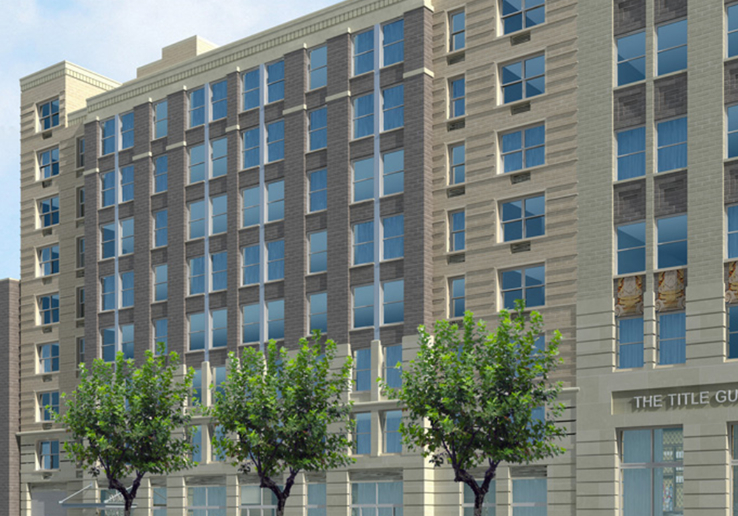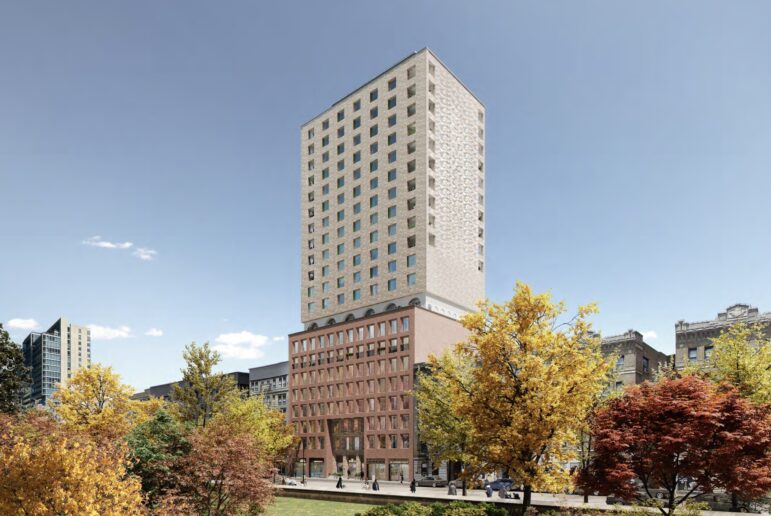
NYC OER
This building containing 100 units of affordable housing was developed on a site in Jamaica, Queens.
New York City is experiencing an affordable-housing crisis: working-class neighborhoods are being redeveloped into luxury apartment buildings. As a result, property values increase, leading to rising rents. The original residents of the community have two options: struggle to pay the rent or face eviction.
It is not a coincidence that the number of homeless New Yorkers sleeping each night in municipal shelters is 78 percent higher than it was ten years ago. This number is even higher if you include people sleeping on a friend’s sofa. There are over 60,000 homeless people living in New York City.
Many of the homeless are employed with decent jobs, such as security guards and assistant teachers, but after paying the family’s bills are unable to afford rising rents. These working-class New Yorkers end up in overcrowded and cramped homeless shelters. Since the 1980s, the city has been supplementing the shelters by placing homeless people into hotels – clearly a problem exists.
To house the homeless New Yorkers, more affordable housing needs to be built. And this requires land. NYC is endowed with 7,600 acres of brownfields; an area over eight times the size of Central Park. Brownfields are lightly contaminated industrial or commercial sites that require environmental remediation. And many of these sites are found in NYC’s outer-boroughs.
However, local residents often fear that brownfield redevelopment and new construction leads to gentrification and rent hikes. For example, a brownfield cleanup site adjacent to the Gowanus Canal, Brooklyn resulted in a luxury high-rise apartment building with studio apartments commanding over $2,000 per month in rent. The development qualified as an affordable housing project by setting aside 86 units, but an astonishing 56,000 applicants entered a lottery system for these units.
Again, the issue is the demand for affordable housing far exceeds the supply.
The current brownfield cleanup program does not allocate enough units for low-income housing. Developers can enroll in the State’s Department of Environmental Conservation’s (DEC) Brownfield Cleanup Program to receive technical assistance as well as tax credits. For NYC, the program is restricted to affordable housing projects. In the past, a building with a minimum of 20 percent units reserved for low-income housing qualified for tax credits, but this number appears to be too low. Instead, what is the right number? Should it be 30 percent, 35 percent, or even 40 percent? What is the right balance to get developers interested and alleviate NYC’s affordable housing problem?
A possible solution to these questions is to create a tiered tax credit system based on the percentage of low-income units. The more units set aside for low-income housing; the tax credits become more generous. Therefore, developers will be incentivized to build more affordable housing.
Some developers build only affordable housing.
Phipps Houses, one of the city’s oldest and largest developers of affordable housing, serves as the model for brownfield redevelopment. Phipps acquires contaminated sites, cleans up the property in accordance with state regulation, and constructs apartments for middle, moderate, and low-income families. Recently, this organization is planning to build 1,200 apartments in East New York on contaminated land.
If more developers follow the Phipps’s model by providing more low-income housing via brownfield redevelopment, then NYC’s homeless population should decrease. Furthermore, the social impacts of gentrification will be alleviated, allowing for more socioeconomic diversity in gentrifying neighborhoods.
Ross Hoffman is a senior at Williams College majoring in Economics and Environmental Policy.









One thought on “CityViews: Brownfield Redevelopment Must Include More Affordable Housing”
Other than lottery how can I get into senior housing. I have never been lucky gambling. Please help me. I am mobility handicap along with having seizure disorder for over 50 years.